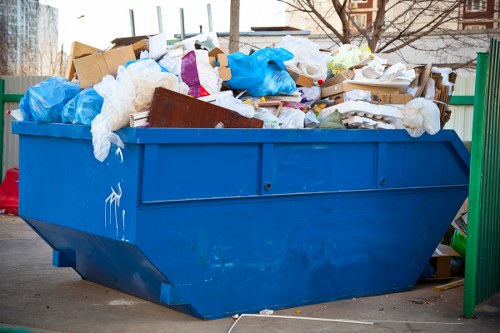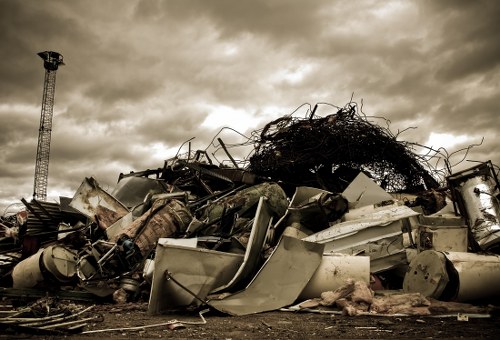Waste Clearance in Office Clearance: Efficient Strategies for a Cleaner Workspace

Introduction to Office Waste Clearance
Maintaining a clean and organized office environment is essential for productivity and employee well-being. Waste clearance in office clearance plays a pivotal role in achieving this goal by ensuring that clutter and unnecessary materials are efficiently removed. This not only enhances the aesthetic appeal of the workspace but also promotes a healthier and more sustainable office culture.
Office waste can range from paper and packaging materials to electronic waste and furniture. Proper management and clearance of these items are crucial to prevent clutter buildup, reduce environmental impact, and comply with regulatory standards.
In this comprehensive guide, we will explore various aspects of waste clearance in office settings, including best practices, benefits, and actionable strategies to streamline the process.

Importance of Effective Waste Clearance
Effective waste clearance is not just about maintaining cleanliness; it has far-reaching implications for both the organization and the environment.
Enhancing Workplace Efficiency
A clutter-free office fosters better concentration and reduces distractions, leading to increased employee productivity. When waste is regularly cleared, it minimizes the time spent on managing unnecessary items and allows employees to focus on their core tasks.
Promoting Environmental Sustainability
Proper waste management contributes to environmental conservation by reducing the amount of waste sent to landfills. Implementing recycling programs and responsibly disposing of electronic waste can significantly lower the organization's carbon footprint.
Compliance with Regulations
Adhering to local and national waste disposal regulations is essential to avoid legal penalties. Effective waste clearance ensures that your office remains compliant with environmental laws and standards.

Types of Office Waste
Understanding the different types of waste generated in an office setting is the first step towards efficient clearance and management.
Paper and Cardboard
Offices typically generate a significant amount of paper waste, including documents, reports, and packaging materials from deliveries. Recycling paper and cardboard not only conserves resources but also reduces waste volume.
Electronic Waste
With the rapid advancement of technology, electronic devices become obsolete quickly. Proper disposal of electronic waste, such as computers, printers, and smartphones, is crucial to prevent environmental contamination from harmful substances.
Plastic and Packaging
Plastic waste from packaging materials, office supplies, and single-use items contributes to pollution. Implementing measures to reduce plastic usage and promoting recycling can significantly mitigate this issue.
- Paper and Cardboard
- Electronic Waste
- Plastic and Packaging
- Furniture and Bulky Items
- Hazardous Materials

Best Practices for Office Waste Clearance
To ensure efficient waste clearance, implementing best practices is essential. These strategies help in streamlining the process and maximizing benefits.
Implementing a Recycling Program
Establishing a comprehensive recycling program encourages employees to segregate waste effectively. Providing clearly labeled bins for different types of waste, such as paper, plastics, and electronics, facilitates easy recycling and disposal.
Regular Waste Audits
Conducting regular waste audits helps in identifying the predominant types of waste and areas where waste generation can be minimized. This proactive approach allows for continuous improvement in waste management practices.
Encouraging Digital Documentation
Transitioning to digital documentation reduces the reliance on paper, thereby decreasing paper waste. Utilizing cloud storage and digital communication tools can significantly minimize the amount of physical waste generated.
Additional Strategies:
- Training Employees on Waste Management
- Partnering with Sustainable Vendors
- Implementing Composting for Organic Waste

Benefits of Professional Waste Clearance Services
While in-house waste management is feasible, partnering with professional waste clearance services offers several advantages.
Expertise and Efficiency
Professional services have the expertise and resources to handle waste clearance efficiently. They ensure that waste is disposed of responsibly and in compliance with regulations.
Cost-Effectiveness
Outsourcing waste clearance can be more cost-effective in the long run. It eliminates the need for investing in waste management infrastructure and reduces the burden on internal resources.
Focus on Core Business
By delegating waste clearance to experts, organizations can focus on their core business activities without being distracted by the complexities of waste management.
Key Benefits:
- Enhanced Operational Efficiency
- Reduced Environmental Impact
- Compliance with Legal Standards
- Improved Workplace Morale
Steps to Implement an Effective Waste Clearance Plan
Creating an effective waste clearance plan involves several steps to ensure comprehensive management and disposal.
Assessing Current Waste Generation
Begin by evaluating the current waste generation patterns. Identify the types and quantities of waste produced to determine the specific needs for clearance and management.
Setting Clear Objectives
Define clear objectives for waste clearance, such as reducing overall waste volume, increasing recycling rates, and ensuring compliance with environmental regulations.
Developing a Waste Management Policy
Create a detailed waste management policy that outlines the procedures for waste segregation, recycling, and disposal. Ensure that this policy is communicated effectively to all employees.
Key Elements of the Policy:
- Waste Segregation Guidelines
- Recycling Procedures
- Disposal Methods for Different Waste Types
- Roles and Responsibilities
- Monitoring and Reporting Mechanisms
Training and Education
Conduct training sessions to educate employees about the importance of waste clearance and the proper methods for segregating and disposing of waste.
Monitoring and Continuous Improvement
Regularly monitor the effectiveness of the waste clearance plan and make necessary adjustments to improve efficiency and outcomes.
Tools for Monitoring:
- Waste Tracking Software
- Regular Audits
- Employee Feedback Mechanisms

Challenges in Office Waste Clearance
Despite the benefits, office waste clearance can present several challenges that need to be addressed for effective management.
Lack of Employee Engagement
Employee participation is crucial for successful waste management. A lack of engagement can lead to improper waste segregation and increased waste accumulation.
Insufficient Infrastructure
Without the necessary infrastructure, such as adequate waste bins and recycling facilities, managing office waste becomes cumbersome and inefficient.
Budget Constraints
Allocating sufficient funds for waste clearance initiatives can be challenging, especially for small and medium-sized enterprises.
Overcoming Challenges:
- Promoting a Culture of Sustainability
- Investing in Waste Management Infrastructure
- Seeking Cost-Effective Waste Clearance Solutions
Addressing Compliance Issues
Staying updated with changing regulations and ensuring compliance can be daunting. Partnering with professional waste clearance services can help navigate these complexities.

Innovative Solutions for Waste Clearance
Embracing innovative solutions can enhance the efficiency and effectiveness of office waste clearance.
Automated Waste Segregation Systems
Automated systems can streamline the process of waste segregation, reducing human error and increasing recycling rates.
Smart Waste Management Software
Utilizing software solutions that track and analyze waste generation helps in making data-driven decisions for waste reduction and clearance.
Green Procurement Practices
Adopting green procurement involves sourcing environmentally friendly products, which in turn reduces the amount of waste generated from packaging and single-use items.
Emerging Technologies:
- AI-Powered Waste Sorting
- IoT-Enabled Waste Tracking
- Eco-Friendly Packaging Innovations
Employee Incentive Programs
Implementing incentive programs encourages employees to actively participate in waste reduction and clearance efforts.
Examples of Incentives:
- Recognition Programs
- Monetary Rewards
- Sustainable Merchandise

Case Studies: Successful Office Waste Clearance
Examining real-world examples can provide valuable insights into effective waste clearance strategies.
Company A: Zero Waste Office
Company A implemented a zero-waste policy, focusing on reducing, reusing, and recycling all forms of waste. By engaging employees and investing in recycling infrastructure, they achieved a significant reduction in waste sent to landfills.
Company B: Digital Transformation
Company B transitioned to a paperless office by adopting digital documentation and cloud storage solutions. This move not only reduced paper waste but also enhanced data accessibility and security.
Company C: Sustainable Procurement
Company C revamped its procurement process to prioritize eco-friendly products and packaging. This shift minimized plastic waste and promoted sustainability throughout their supply chain.
Lessons Learned:
- Commitment from Leadership
- Employee Involvement
- Continuous Evaluation and Adaptation
Impact Assessment
Assessing the impact of these initiatives revealed not only environmental benefits but also improved employee morale and cost savings.

Future Trends in Office Waste Clearance
The future of office waste clearance is shaped by evolving technologies and increasing emphasis on sustainability.
Circular Economy Models
Circular economy principles focus on designing waste out of the system. Offices adopting these models emphasize reuse, refurbishment, and recycling to create a closed-loop system.
Integration of AI and Machine Learning
AI and machine learning can revolutionize waste management by predicting waste generation patterns and optimizing clearance schedules.
Increased Focus on Biodegradable Materials
The shift towards biodegradable and compostable materials reduces the environmental impact of office waste, making disposal more sustainable.
Anticipated Developments:
- Enhanced Waste Tracking Technologies
- Greater Adoption of Renewable Resources
- Policy-Driven Sustainability Initiatives
Employee-Centric Waste Programs
Future programs will likely place a greater emphasis on engaging employees through interactive and personalized waste management initiatives.
Potential Innovations:
- Mobile Apps for Waste Reporting
- Gamification of Waste Reduction
- Personalized Sustainability Goals

Conclusion: Embracing Effective Waste Clearance
Waste clearance in office clearance is an integral component of a sustainable and productive work environment. By understanding the types of waste, implementing best practices, overcoming challenges, and leveraging innovative solutions, organizations can achieve efficient waste management.
Investing in professional waste clearance services can further enhance these efforts, ensuring compliance, cost-effectiveness, and a positive environmental impact.
Start your journey towards a cleaner and more sustainable office today by prioritizing effective waste clearance strategies.
Contact us today to learn more about how we can help streamline your office waste clearance process and create a greener workspace for your team.
Frequently Asked Questions
- Expert Office Clearance Solutions in Harlington
- Comprehensive Guide to Office Clearance in Botany Bay
- Professional Office Clearance Solutions in Forest Gate
- Efficient Office Clearance Solutions in Goodmayes
- Efficient Office Clearance Services in Woodlands
- Comprehensive Office Clearance Services in Pratts Bottom
- Expert Office Clearance Services in St Giles
- Comprehensive Office Clearance Services in Willesden
- Comprehensive Guide to Office Clearance Services in Cricklewood
- Comprehensive Guide to Office Clearance Services in Pinner
- Essential Guide to Office Clearance Services in Hayes
- Efficient and Eco-Friendly Office Clearance Services in Foots Cray
- Top-Notch Office Clearance Solutions in Winchmore Hill
- Comprehensive Guide to Office Clearance Services in Friern Barnet
- Top-Notch Office Clearance Services in Parsons Green
- Efficient and Responsible Office Clearance Services in Barnsbury
- Comprehensive Guide to Office Clearance in Haggerston